As organizations expand, so does the complexity of their operations; i.e., the volume of information handled by the company increases in size. The information stored within the company may belong to a diverse group of sectors with varying degrees of sensitivity attached to them. As a result, organizational activities often fall under the purview of several different regulatory and compliance bodies.
Not to mention, as an organization experiences rapid changes across its infrastructure, it'll need to ensure that its operational activities are in line with business targets. To tackle these logistical challenges, it is important for organizations to adopt an organized approach; the unified concept that ties enterprise integrity, adherence of regulations, and resilience to risks is governance, risk, and compliance (GRC).
With overlapping features shared among the three disciplines, an integrated GRC solution reduces duplicated efforts, which can help organizations streamline operations, cut costs, and encourage cross-domain analytics to deliver expansive results.
Governance
Describes the executive decisions made by an organization to ensure that its operations are working towards a collective business goal. Organizational governance combines management information and the control structures and stakeholders that influence, enforce, and monitor key policy decisions.
The key components that determine effective governance include internal assessments, risk management, and compliance monitoring reports. Some of the most prominent frameworks that can help with implementing IT governance are:
- Control Objectives for Information and Related Technologies (COBIT): Created by ISACA, COBIT is designed for IT enterprise management to bind technical challenges, business risks, and key decision makers. Initially designed for IT auditing, the latest iteration, COBIT 5, is built on five principles:
- 1.Fulfilling the requirements of key stakeholders
- 2.Implementing end-to-end coverage of the entire enterprise
- 3.Unifying several frameworks
- 4.Paving the way for a holistic approach to run organizations
- 5.Separating management from governanc
- Information Technology Infrastructure Library (ITIL): A process-based IT service management (ITSM) framework that allows business to leverage their ITSM capabilities for better results. ITIL consists of five elements for service management:service strategy, service design, service transition, service operation, and continual service improvement.
- Committee of Sponsoring Organizations of the Treadway Commission (COSO): The COSO framework addresses several discrepancies that affect the internal controls of an organization. With more emphasis on the business side of an enterprise, COSO classifies internal control objectives into three categories: operations, reporting, and compliance.
- Factor Analysis of Information Risk (FAIR): FAIR focuses on the cybersecurity aspects of an organization, helping companies make crucial steps to remediate the presence of bad actors and security gaps.
- Capability maturity model integration (CMMI): A methodology that aims to deliver process improvement, thereby leaving no room for operational laxity and haphazard functioning. CMMI introduces a ratings scale that ranges from one to five in order to determine an organization's process stability, quality, and profitability maturity level.
Risk
The existing or perceived challenges an organization must overcome to ensure smooth functioning. The types of risks faced by a company include:
- Operational risk: Systemic vulnerabilities that affect the operations of a company amount to organizational risk. They can originate from either within or outside, with examples of the latter being natural or man-made calamities and global crises that can destabilize the global supply chain. The internal factors that contribute include flawed organizational policies, unpatched hardware, cyberattacks, insider trading, human errors, and the prevalent use of defective devices or other products within the establishment.
- Compliance risk: Risks brought in by non-compliance with regulatory frameworks.
- Financial risk: Potential hazards that affect an organization's financial health.
Compliance
Refers to the need for organizations to conform to a set of regulatory laws and guidelines. Compliance ensures that companies do not infringe any ethical boundary at the cost of fulfilling their objectives.
GRC Capability Model: The ideal workflow
According to OCEG, an ideal GRC practice should incorporate the following components:
- Learn: Gaining knowledge about the organization's context, internal policies, and culture, which can be incorporated to create strategies, roadmaps, and objectives.
- Align: Using effective decision-making tools to create actionable strategies, objectives, and processes that are in line with the company's values, requirements, adversaries, and opportunities.
- Perform: Executing actions that can realize the strategic roadmaps while avoiding operational flaws by rewarding desirable actions and remediating the counter-productive ones.
- Review: Reassessing the operational effectiveness of the plans and their respective actions in addition to performing course correction and bringing up measures to ramp up the organization's workflow efficiency.
Components of a GRC solution
A foolproof GRC solution can ease the workload of network administrators by automating mundane tasks such as policy enforcement and monitoring. GRC tools unify diverse tasks and save the workforce from focusing their efforts on redundant, repetitive tasks that overlap between different teams. GRC solutions should also provide the necessity functions that are in line with the requirements of compliance laws and also aid in auditing entities, systems, and vendors that are associated with the organization.
Some of important components of a GRC solution include:
Policy management
Deals with the conception and enforcement of company-defined regulations that shape up user and device activity within the organizational network. Apart from administering the end-to-end life cycle of company policies, the component also establishes communication channels to escalate policy violations via alerts and notifications along with dashboards that track, report on, and manage incidents of policy violations.
Compliance management
A continuous evaluation to ensure that an organization obeys security standards along with legal and regulatory frameworks while also mapping new compliance and licensing requirements as per the organization's evolving infrastructure.
The first step to delivering compliance management is regulatory mapping, which involves understanding and addressing the obligatory requirements expected from an organization by the regulation. This can be carried out by conducting risk surveys to gain inferences on the organization's security posture and the issues faced by the employees throughout different areas of the organization that amount to non-compliance.
Besides dashboards and auditing systems that administer and report anomalous activities, users must be educated on regulations so that they can incorporate the best practices in their day-to-day operations.
Risk management
The process of identifying the possible and existing threats that endanger an organization and the subsequent mitigation measures taken by the organization constitute risk management. The five steps that amount to risk management include:
- Identify: Estimating the amount of existing or perceived risk elements of an organization. To identify practical vulnerabilities and other threats, companies can leverage tools and techniques such as risk analysis questionnaires, cybersecurity risk assessments, and penetration testing.
- Analyze: Determining the scope of the risks, i.e., zeroing in on the severity of risk and how it affects operations.
- Evaluate: Prioritizing risks based on their frequency and the intensity of damage they can cause to the business. Risk assessments come in two types: qualitative and quantitative risk assessment. While qualitative risk assessment involves dealing with adversaries that cannot be characterized by metrics (such as global calamity), quantitative risk assessment evaluates risks that can be quantified, like financial risks, IT risks, etc.
- Treat the risk: Strategizing and executing actions required to mitigate the risk. By deploying incident response plans and patch management, an organization can eliminate risks and also fortify its IT infrastructure.
- Monitor: Monitoring IT infrastructures and identifying key indicators before they escalate into full-blown risks that can jeopardize business-critical assets and processes. Evolving risks and expanding threat surfaces are part of dynamic business environments. By deploying a combination of AI- and ML- powered, metadata-driven data analytics with behavioral tools such as SIEM and UEBA, monitoring and reportage of threats can be effectively implemented.
Vendor risk management
Parent organizations must intervene in improving the security posture of vendor companies and solutions, as they are seen as a lucrative threat vector by attackers to unleash prolonged supply chain attacks. This includes gaining visibility into the security metrics of third-party organizations, such as non-compliance and patch management; aggregating risk scores for partner companies; and placing tools that bridge the communication gap between parent and third- or fourth-party companies, such as unified dashboards to track, assess, and monitor shared security and business goals.
Why organizations need GRC
For companies, the ability to foresee, withstand, and react to adversaries requires a thorough knowledge of understanding the pain points and success factors that affect their supply chain. Being a critical component of GRC, operational resilience can be inherently achieved with better effect by automating key processes that identify vulnerabilities in workflows. Some of the main benefits of GRC that complement a resilient organization include:
Enhanced transparency
Integrated GRC solutions allow better visibility to the risk indicators and appetite due to the breakdown of siloed mechanisms and interoperable knowledge sharing across domains. This means employees, process owners, and stakeholders can get a better overview of the strengths and weaknesses of an organization and make informed decisions and policies accordingly. With better transparency, it becomes easier for organizations to create risk profiles and action plans for exceptional cases and the subsequent risk and compliance factors for such situations.
Protection against financial pitfalls
Non-compliance with regulatory and license obligations can result in companies paying hefty sums as fines. This, in turn, affects the financial well-being of organizations. A 2017 survey by Ponemon and Globalscape shows that organizations guilty of non-compliance must pay up to 2.71 times the cost required to achieve effective compliance.
The EU's General Data Protection Regulation (GDPR), considered one of the most stringent regulations in the IT landscape, can levy fines of up to 20 million euros or 4% of an organization's total global turnover of the preceding fiscal year in cases of non-compliance.
Additionally, GRC saves organizations from financial and workforce burden by eliminating repetitive tasks. Compliance, in addition to other GRC features, help companies navigate the perils of avoidable overheads that can eat up a major chunk of their profits.
Business continuity
An intrinsic ability of GRC solutions to gauge adversaries that affect a company in the short, medium, and long term can guarantee a longer shelf life to the critical processes happening within. GRC gives leeway for organizations to prioritize critical functions and assets and aids in fortifying them (totally or partially) in the face of an inevitable operational risk, such as an external calamity like a pandemic, for instance. In such cases, when all other operations are compromised, these essential operations are up and running.
How AD360 fulfills organizational GRC needs
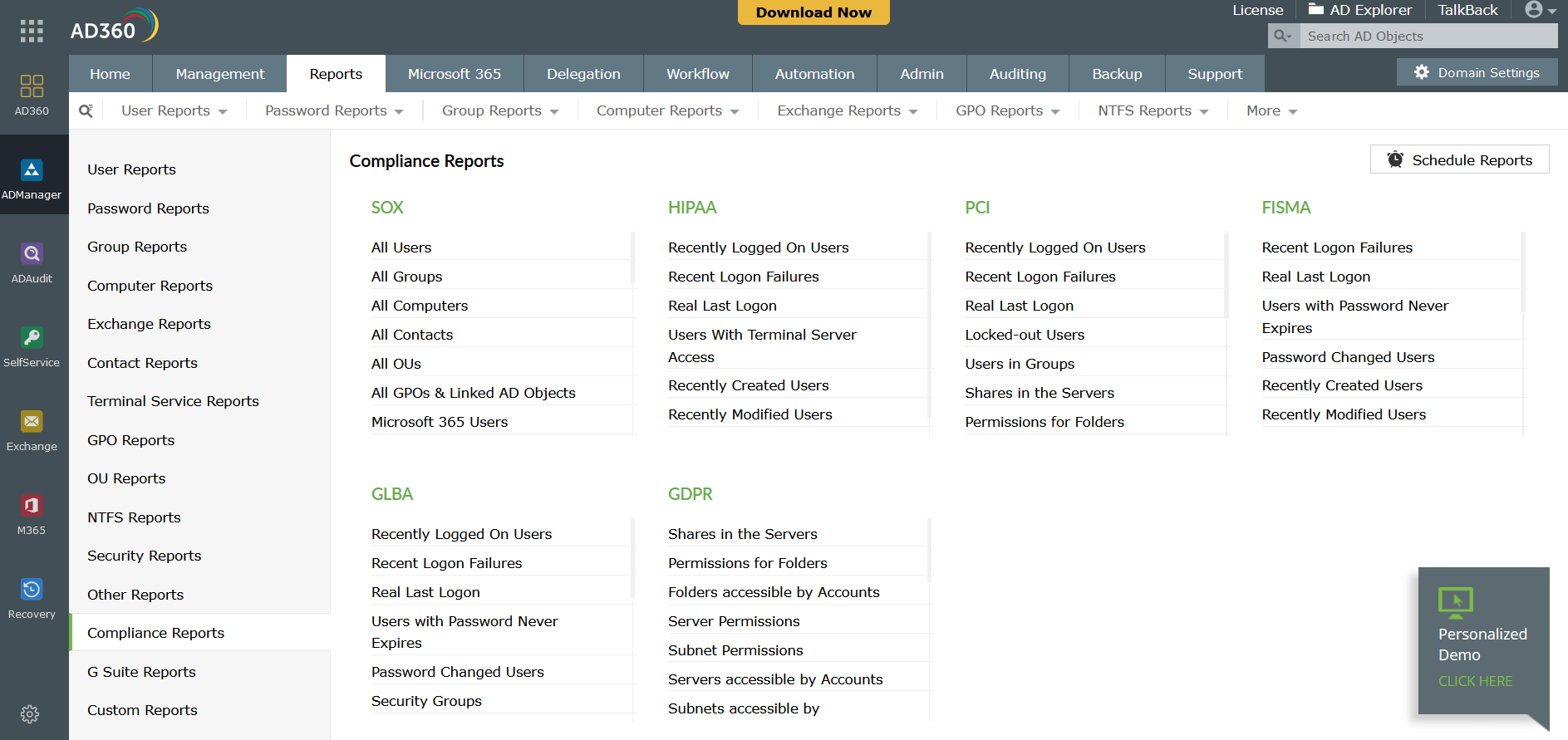 Compliance repository for AD360's AD management module
Compliance repository for AD360's AD management module
The AD360 suite has built-in features that can be mapped with the obligations of various regulatory frameworks such as:
Health Insurance Portability and Accountability Act (HIPAA)
A regulatory standard for organizations that store, process, transmit, and maintain protected health information. For an AD environment to be secure and protected from unauthorized access, it is essential to comply with HIPAA. AD360 fills the gap left by native tools when it comes to HIPAA compliance by providing an end-to-end audit trail providing insights on:
- Users whose recent logon attempts failed.
- Users who have logged on in the last N days.
- Users' real last logon times.
- Users who have permissions to access terminal servers.
- Recently modified GPOs.
- User accounts that were created or modified over the last N days.
- Users who haven't changed their passwords recently.
- Users whose passwords never expire.
Additionally, AD360 guides organizations on compliance to the provisions of section 164.308 of the HIPAA framework.
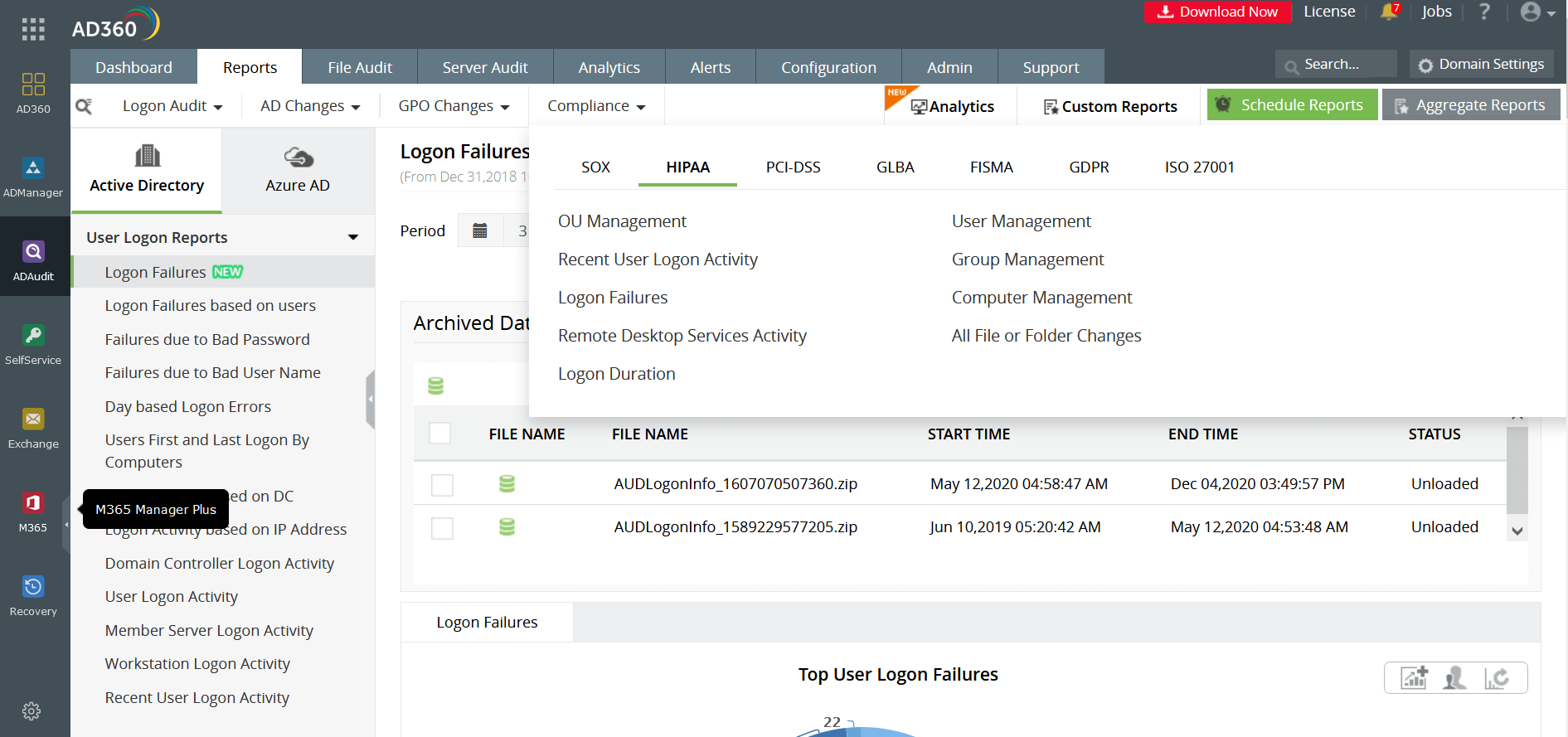 AD360's AD auditing features for HIPAA compliance
AD360's AD auditing features for HIPAA compliance
Sarbanes-Oxley (SOX) Act
Introduced in 2002 by the US Congress, SOX aims to curb fraudulent financial practices by companies and its effect on investors. The key objectives of this legislation is to establish trusted internal controls, transparent financial disclosures, efficient auditing infrastructures, and policy making among companies. SOX compliance in an IT infrastructure can be achieved by putting the right identity and access management system in place, which aids in administering the internal controls of a company. AD360 performs Active Directory reports that can be categorized under sections of SOX compliance such as:
- Security policies and procedures
- Risk analysis and management
- Disaster recovery
- Auditing
AD360 also helps organizations satisfy clauses that come under section 302 of SOX, which mandates a set of internal procedures created to ensure financial compliance.
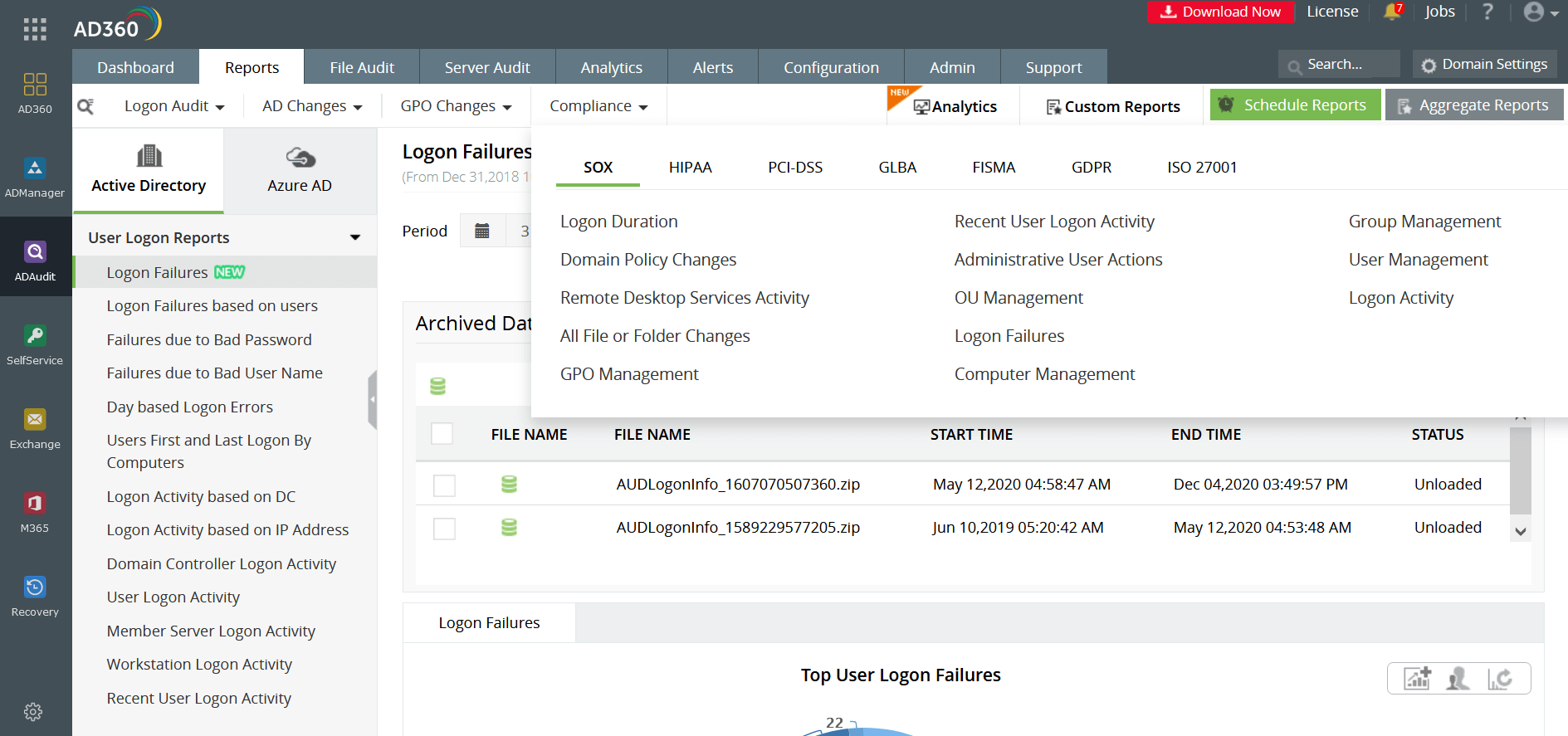 AD360's AD auditing features for SOX compliance
AD360's AD auditing features for SOX compliance
Payment Card Industry Data Security Standard (PCI DSS)
One of the most significant regulatory policies of the industrial climate at present, the central objective of the PCI DSS framework is to standardize and secure the operational and technical practices related to payment card information. Any business that accepts or processes payment card details must comply with PCI DSS.
Since the law directly addresses the transactional side of a business, being PCI DSS compliant can provide added assurance to customers regarding the security of their card-related information. PCI DSS compliance makes organizations trustworthy and reliable. With AD360 at the helm, restricted access to cardholder data can be enforced by implementing two-factor authentication and performing reports on logon attempts, audit policy changes, and permission changes among other operations.
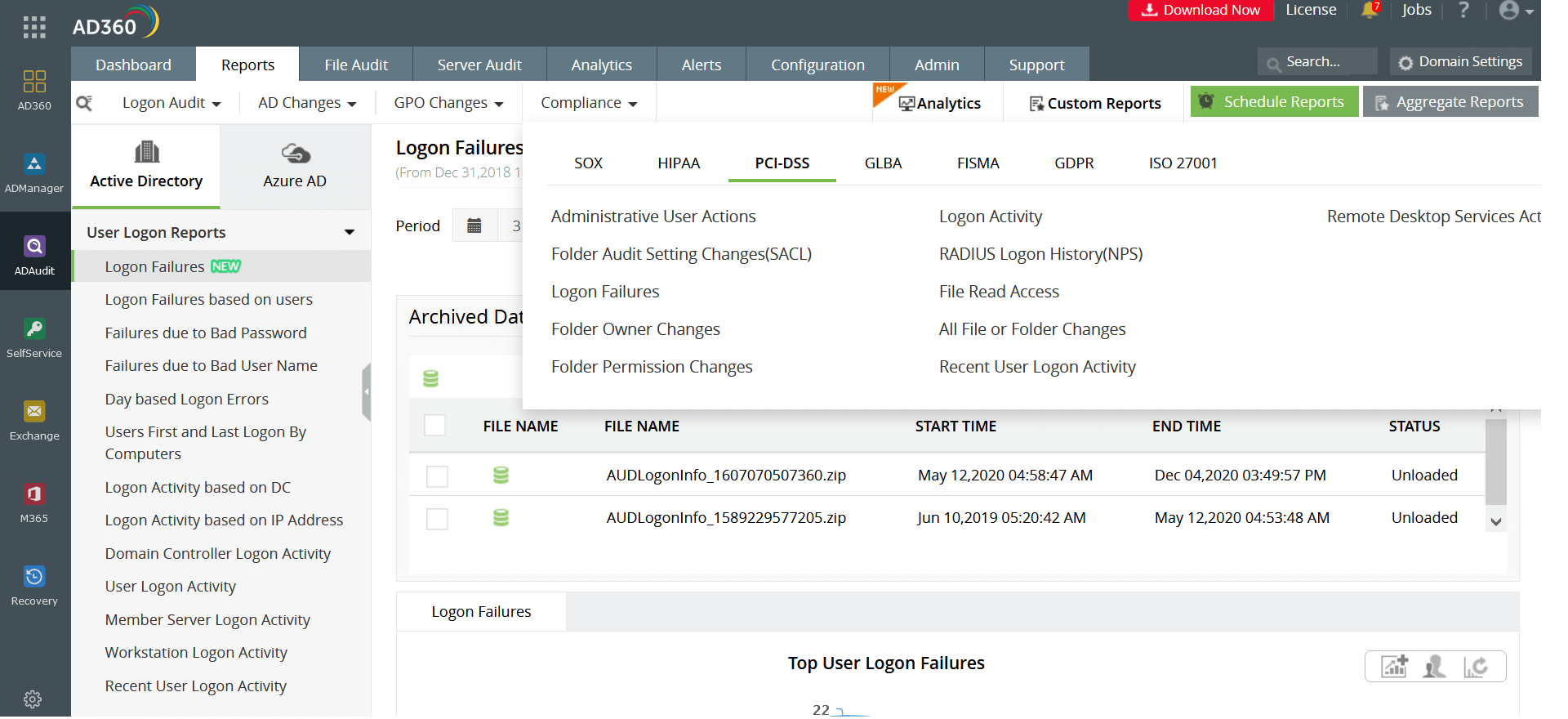 AD360's AD auditing features for PCI-DSS compliance
AD360's AD auditing features for PCI-DSS compliance
Federal Information Security Management Act (FISMA)
Passed in 2002, this US federal law requires federal agencies to secure their critical infrastructures and data assets. AD360 secures federal assets by monitoring the organization's Windows server environment and by notifying about changes with email notifications along with periodic reports. AD360 features a FISMA compliance kit to ease the adherence process.
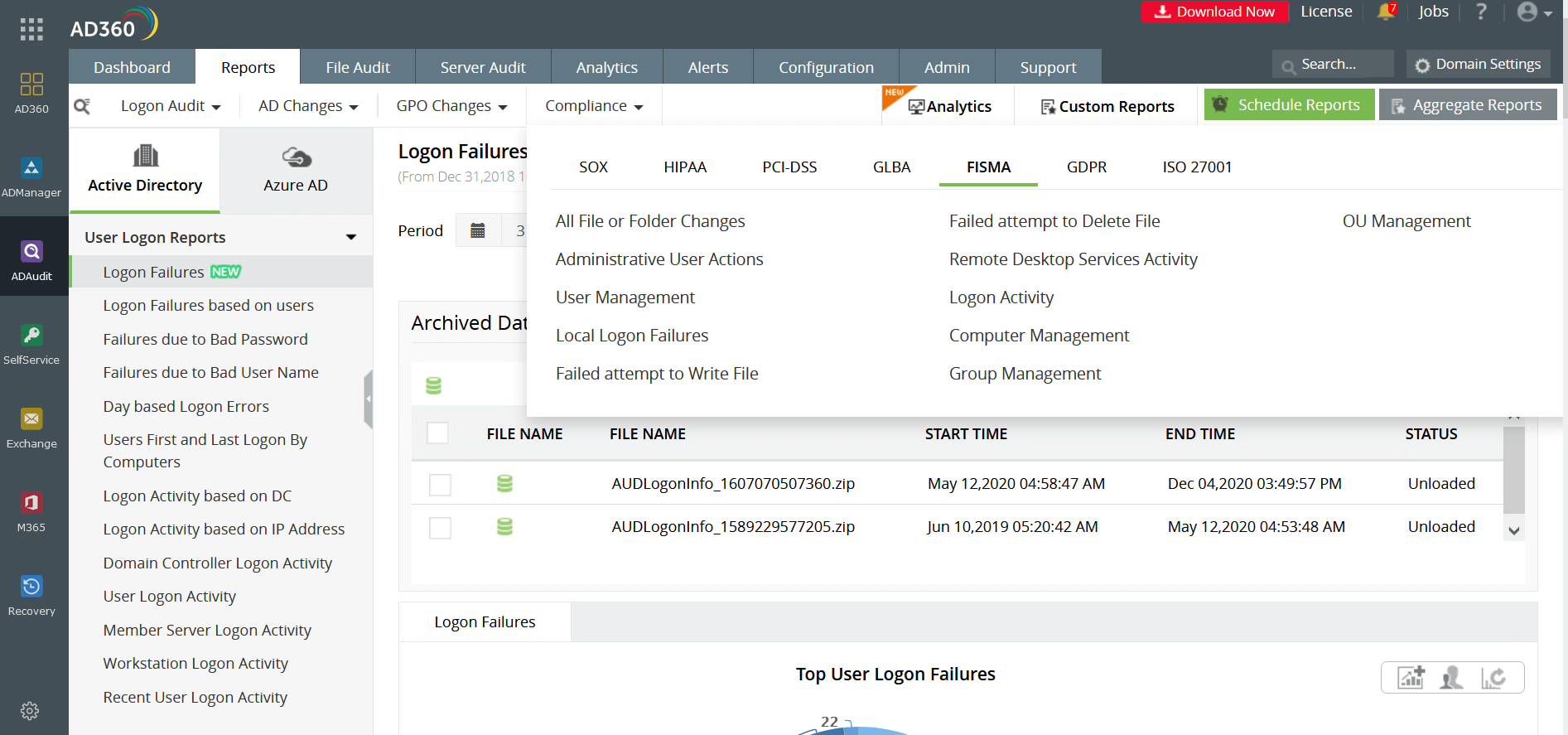 AD360's AD auditing features for FISMA compliance
AD360's AD auditing features for FISMA compliance
General Data Protection Regulation (GDPR)
A regulatory framework that must be complied with by organizations that operate from or serve customers that belong to the European Union. The GDPR deals with securing the personal data of customers, employees, and prospects held by a company. AD360 ensures organizations are equipped with the appropriate measures that ensures GDPR compliance. With AD360, organizations can:
- View members of specified groups as well as group details.
- Identify the shared folders present in servers and audit shared folder permissions.
- List the access rights users and groups have over folders in specified paths or locations.
- See which folder and server permissions specified user accounts have.
- List the users and groups that have access to specific servers.
- Notify the appropriate individuals on requests that have been raised, reviewed, or approved.
- Create rules to assess and assign requests to appropriate technicians.
- Review the management actions to be carried out by technicians.
- View workflow requests that were created and assigned to the help desk.
- List all actions performed by help desk technicians.
Furthermore, AD360 can fortify the personal data of organizations by checking logon attempts to detect unauthorized access. By providing visibility on login information, privilege escalations and other modifications in the user's life cycle, AD360 increases the ability of organizations to detect information breaches while ensuring GDPR compliance.
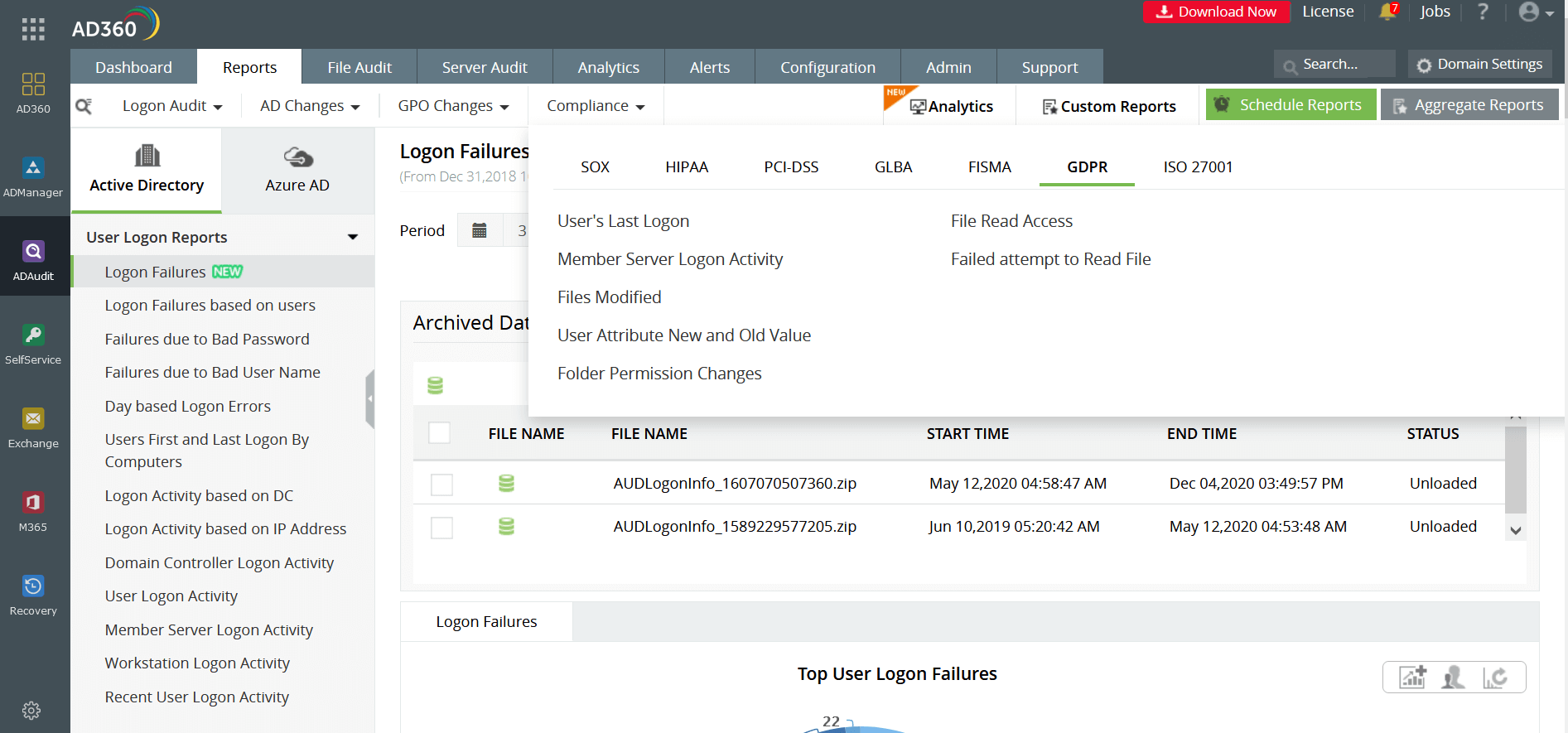 AD360's AD auditing features for GDPR compliance
AD360's AD auditing features for GDPR compliance
Gramm-Leach-Bliley Act (GLBA)
Also known as the Financial Services Modernization Act, the policy requires financial institutions—companies that offer consumers financial products or services like loans, financial or investment advice, or insurance—to be transparent about their information-sharing practices to their customers and to safeguard sensitive data. A mandatory compliance requirement for every financial organization, the GLBA also states that companies must secure their assets from foreseeable threats to security and data integrity. AD360 delivers preventive measures with 24/7 monitoring and easy-to-view preconfigured reports and alerts.
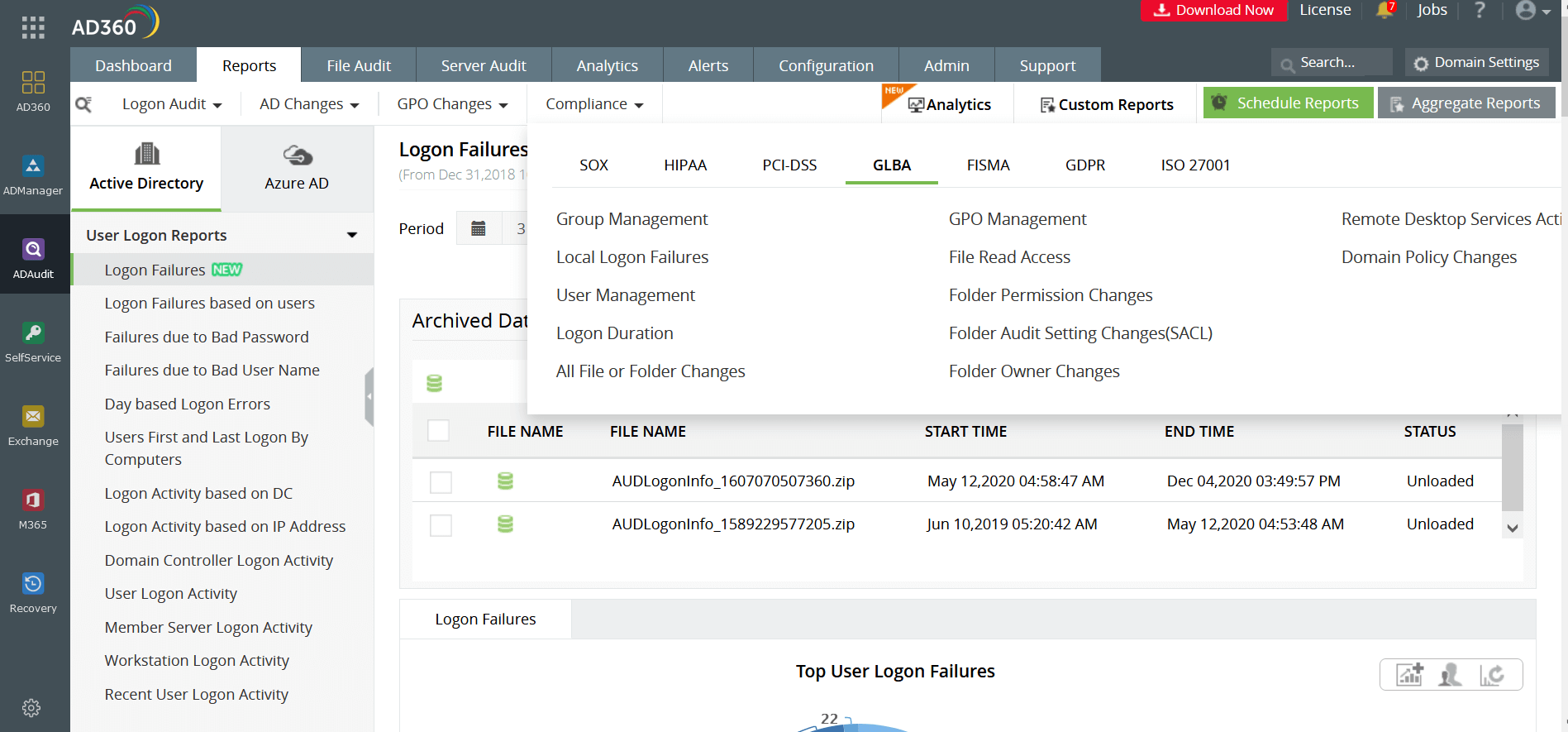 AD360's AD auditing features for GLBA compliance
AD360's AD auditing features for GLBA compliance
ISO 27001
Emphasizes the need for companies to establish, implement, administer, and continually improve an information security management system within the context of an organization. ISO 27001 features 11 clauses, of which, four to 10 define the mandatory requirements to be met. AD360's ADAudit Plus repurposes event log data from across your Active Directory (AD) domain controllers, file servers, Windows servers, and workstations into real-time reports and alerts.
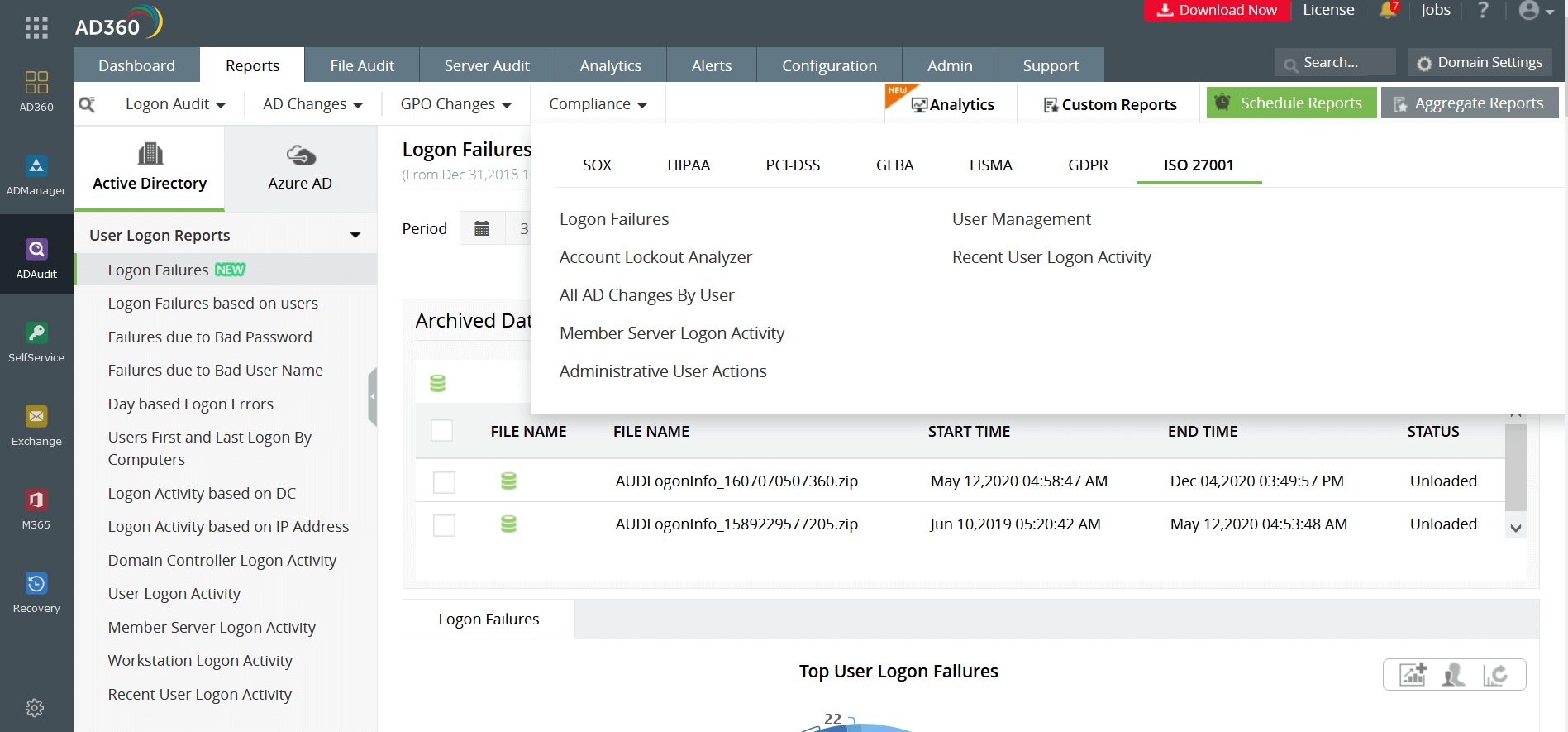 AD360's AD auditing features for ISO 27001 compliance
AD360's AD auditing features for ISO 27001 compliance
Brazil's General Data Protection Law (LGPD)
The LGPD governs the collection, usage, and processing of PII in Brazil. The LGPD directs organizations to implement an incident response plan that entails prompt reporting of security incidents. With customizable reports that can be generated in different file formats, ManageEngine AD360 can elevate an organization's incident reporting and response to help with LGPD compliance.
For instance, one of AD360's salient features is file integrity monitoring, which enables IT admins to detect any unauthorized attempts by users to tamper with or change the contents of critical documents.
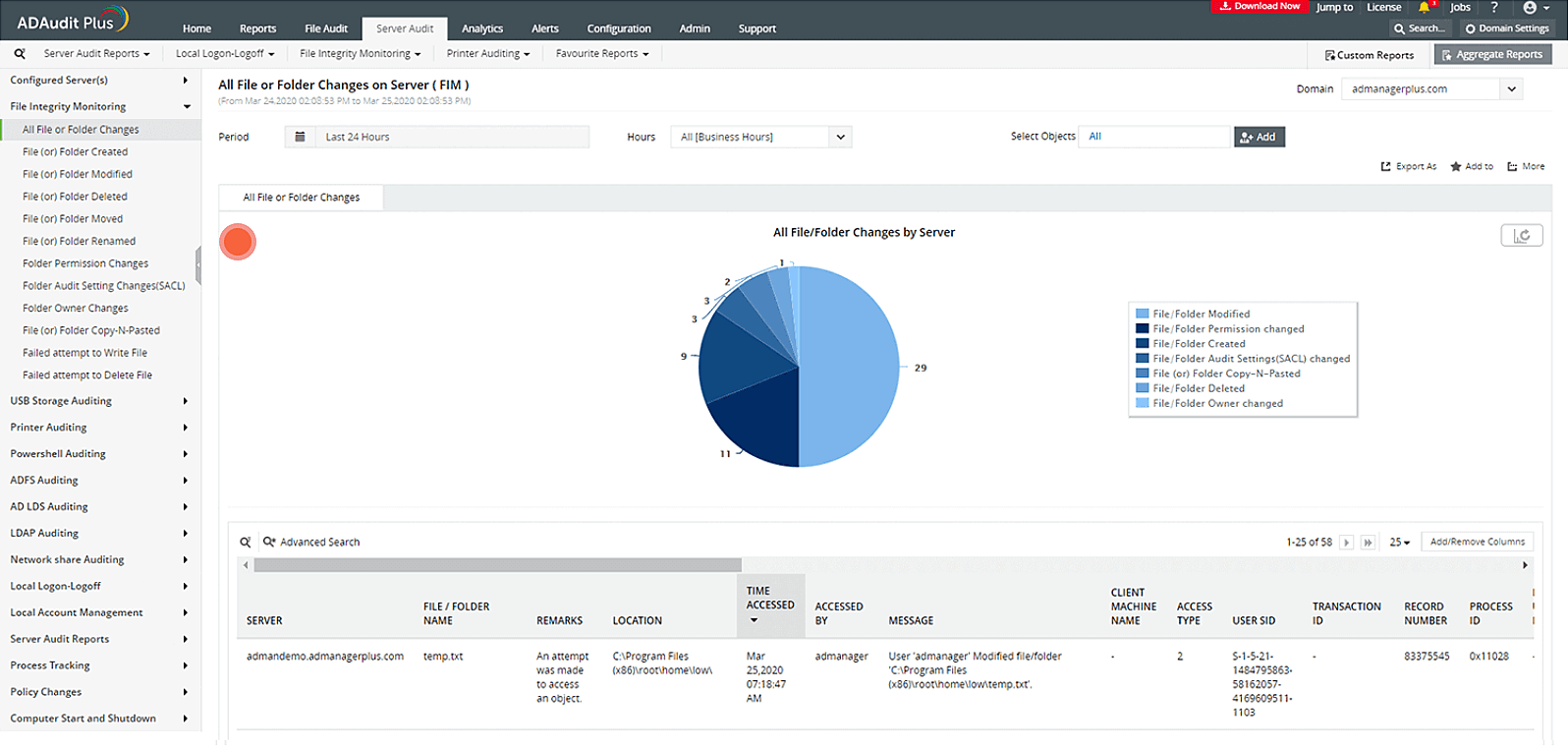 AD360's File Integrity Monitoring feature
AD360's File Integrity Monitoring feature
How AD360 takes care of your IAM needs
-
Identity protection with UBA
Detect, investigate, and mitigate threats such as malicious logins, lateral movement, malware attack, and privilege abuse with machine learning-based UBA; automate your threat response.
Learn More → -
Identity automation
Eliminate redundancy and human errors, and improve business processes by automating user provisioning, stale account cleanup, and other identity-related tasks.
Learn More → -
Identity lifecycle management
Streamline identity management throughout the entire lifecycle of users—right from provisioning, to role changes and deprovisioning.
Learn More → -
Multi-factor authentication
Elevate trust in identities and mitigate impersonation attacks using biometric, authenticator apps, and other advanced authentication methods.
Learn More → -
Identity analytics
Use over 1000 preconfigured reports to monitor access to crucial data and satisfy compliance mandates.
Learn More →
Rethink your IAM with AD360
AD360 helps you simplify IAM in your IT environment by giving users quick access to the resources they need while establishing tight access controls to ensure security across on-premises Active Directory, Exchange Servers, and cloud applications from a centralized console.
Demo request received
Thank You for the interest in ManageEngine AD360. We have received your personalized demo request and will contact you shortly.
Get a one-on-one product walk-through
2020 Zoho Corporation Pvt. Ltd. All rights reserved.